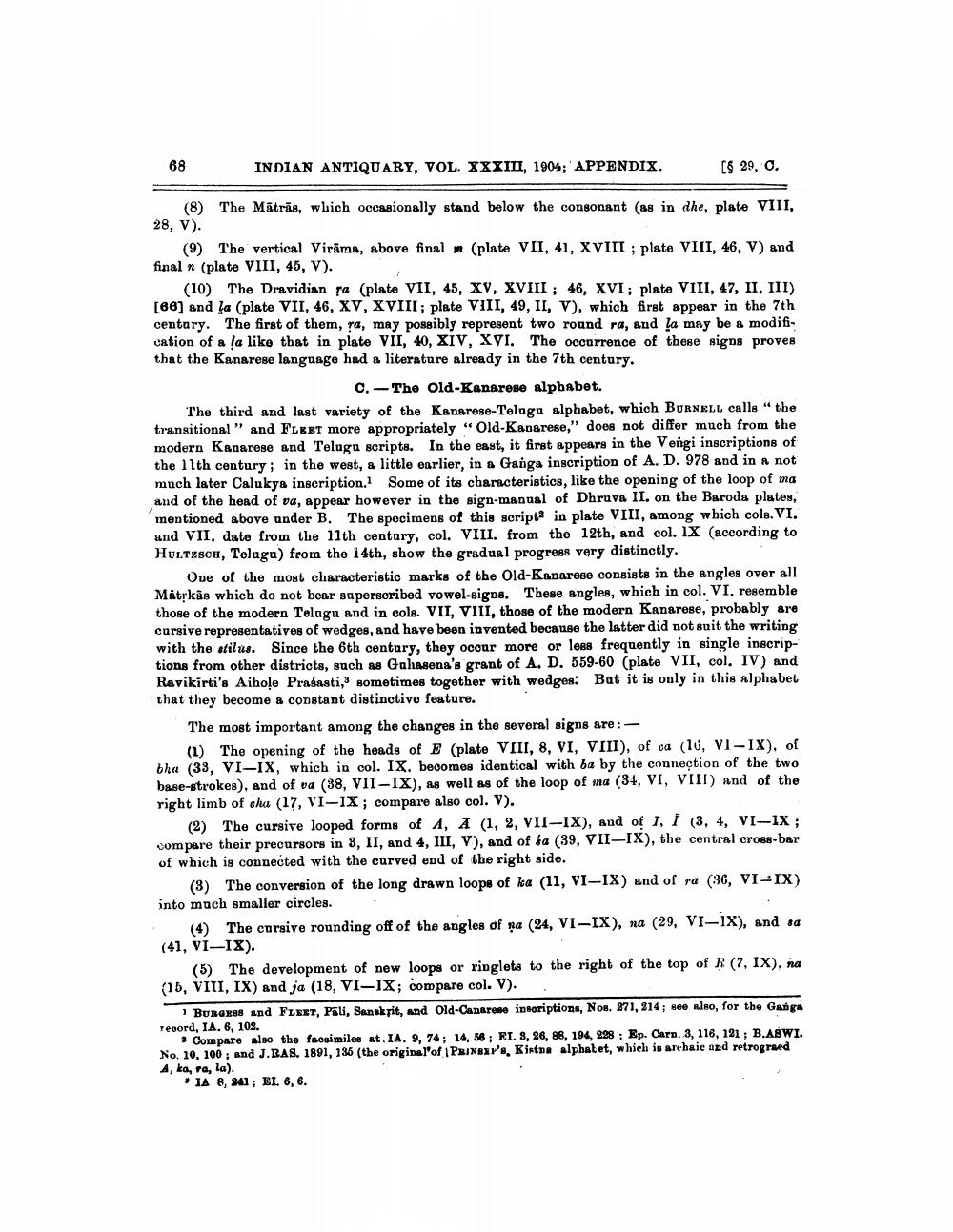________________
INDIAN ANTIQUARY, VOL. XXXIII, 1904; ' APPENDIX.
[$ 29, O.
(8) The Matras, wbich occasionally stand below the consonant (as in dhe, plate VIII, 28, V).
(9) The vertical Virāma, above final mt (plate VII, 41, XVIII ; plate VIII, 46, V) and final n (plate VIII, 45, V).
(10) The Dravidian sa (plate VII, 45, XV, XVIII ; 46, XVI; plate VIII, 47, II, III) [66] and la (plate VII, 46, XV, XVIII; plate VIII, 49, II, V), which first appear in the 7th century. The first of them, ra, may possibly represent two round ra, and la may be a modification of a !a like that in plate VII, 40, XIV, XVI. The occurrence of these signs proves that the Kanarese language had a literature already in the 7th century.
C. -The Old-Kanarese alphabet. The third and last variety of the Kanarese-Telagu alphabet, which BURNELL calls the transitional ” and FLEET more appropriately “Old-Kanarese," does not differ much from the modern Kanarese and Telugu scripts. In the east, it first appears in the Vengi inscriptions of the Ilth century; in the west, a little earlier, in a Ganga inscription of A. D. 978 and in a not much later Calukya inscription. Some of its characteristics, like the opening of the loop of ma and of the head of va, appear however in the sign-manual of Dhruva II. on the Baroda plates, mentioned above under B. The spocimens of this script in plate VIII, among which cols. VI. and VII, date from the 11th century, col. VIII. from the 12th, and col. IX (according to HULTZSCH, Teluga) from the 14th, show the gradual progress very distinctly.
One of the most characteristio marks of the Old-Kanarese consists in the angles over all MåtȚkas which do not bear saperscribed vowel-signs. These angles, which in col. VI, resemble those of the modern Telugu and in cols. VII, VIII, those of the modern Kanarese, probably are cursive representatives of wedges, and have been invented becance the latter did not suit the writing with the stilus. Since the 6th century, they occur more or less frequently in single inscriptions from other districts, such as Gahasena's grant of A. D. 559-60 (plate VII, col. IV) and Ravikirti's Aihole Prasasti, sometimes together with wedges: Bat it is only in this alphabet that they become a constant distinctive feature.
The most important among the changes in the several signs are:
(1) The opening of the heads of E (plate VIII, 8, VI, VIII), of oa (10, VI-IX), of bha (33, VI-IX, which in col. IX. beoomes identical with ba by the connection of the two base-strokes), and of va (38, VII-IX), as well as of the loop of na (34, VI, VIII) and of the right limb of cha (17, VI-IX; compare also col. V).
(2) The cursive looped forms of 4, A (1, 2, VII-IX), and of I, I (3, 4, VI-IX; compare their precursors in 3, II, and 4, III, V), and of ba (39, VII-IX), the central cross-bar of which is connected with the curved end of the right side.
(3) The conversion of the long drawn loops of ka (11, VI-IX) and of ra (36, VI-IX) into much smaller circles.
(4) The cursive rounding off of the angles of na (24, VI-IX), na (29, VI-IX), and sa (41, VI-IX).
(5) The development of new loops or ringlets to the right of the top of R (7, IX), na (15, VIII, IX) and ja (18, VI-IX; compare col. V).
1 BURX88 and FLERT, Pali, Sanskrit, and Old-Canarose insoriptions, No8, 271, 214 ; see also, for the Ganga Teoord, IA. 6, 102.
* Compare also the facsimiles at IA. 9, 74; 14, 58; EL. 8, 26, 88, 194, 228; Ep. Carn. 3, 116, 121; B.ABWI. No. 10, 100; and J.RAS. 1891, 135 (the original'of\PRINBEY' Kata alphabet, which is archaic and retrograd A, ka, ra, la).
IA 8, 841; EL. 6, 6.




